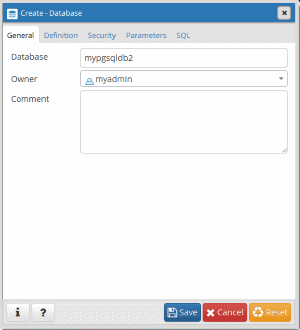
- #POSTGRESQL LIST DATABASES HOW TO#
- #POSTGRESQL LIST DATABASES PDF#
- #POSTGRESQL LIST DATABASES ARCHIVE#
- #POSTGRESQL LIST DATABASES PASSWORD#
PostgreSQL has its own command-line tool psql, which can be used to list databases using meta-commands and SQL queries, or you can simply use pgAdmin4 for listing all databases present on a server.

To determine the sizes of PostgreSQL tables, however, you must use the psql command-line program as described in the previous section. To list all the databases currently running in a server, users can adopt different ways in PostgreSQL. You can use the phpPgAdmin web interface to determine the sizes of PostgreSQL databases. When you connect with the database utilizing the psql command, you may checklist all of the databases within. Tables Show table Show details List tables from current schema List tables from all schemas List tables for a schema Copy table data to CSV file Check. SELECT pg_size_pretty( pg_total_relation_size(' tablename') )
#POSTGRESQL LIST DATABASES PDF#
Besides the sample database, we provide you with a printable ER diagram in PDF format. Replace tablename with the name of the table that you want to check: The database file is in zipformat ( dvdrental.zip) so you need to extract it to dvdrental.tar before loading the sample database into the PostgreSQL database server. SELECT pgdatabase.datname as databasename, pgdatabasesize(pgdatabase.datname)/1024/1024 AS sizeinmb FROM. Example of the informationschema. We can also use the dv psql command to do the same thing.
#POSTGRESQL LIST DATABASES HOW TO#
To determine the size of a table in the current database, type the following command. How to List All Views in a PostgreSQL Database Posted on Januby Ian In PostgreSQL, we can use the informationschema.views view to return all views in a database. TablePlus supports most of the popular databases such as MySQL. Now if you want to see other databases you can change user/database by c. Its purpose-built for simplifying database management and reducing administrative costs. Then you should search for the folder name by that number under C:\Program Files (x86)\PostgreSQL\8.2\data\base. You can list all databases and users by l command, (list other commands by ). Step 2: Tell the database to terminate backup mode. z : this attribute to the command indicates to postgreSQL to compress the output file. This introduces flexibility when re-importing the file.


#POSTGRESQL LIST DATABASES ARCHIVE#
SELECT pg_size_pretty( pg_database_size(' dbname') ) On Windows7 all the databases are referred by a number in the file named pgdatabase under C:\Program Files (x86)\PostgreSQL\8.2\data\global. By including this, the user states that the archive file will have a custom format. Replace dbname with the name of the database that you want to check: To determine the size of a database, type the following command. When you type the correct password, the psql prompt appears.
#POSTGRESQL LIST DATABASES PASSWORD#

I don't see a way to get the list of databases's schemas without connecting to it first. To list all the database present in the current database server use one of the following commands: Syntax: \l or \l+.


 0 kommentar(er)
0 kommentar(er)
